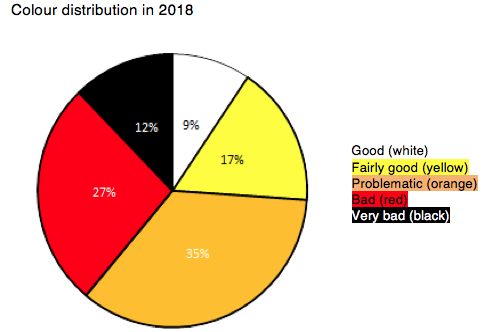On April 24, Reporters Without Borders published the 2018 World Press Freedom Index, an annual ranking that the NGO releases of different country’s relationships with media outlets. While this index is incredibly interesting, reading through it gets more and more sour as the years pass due to the amount of countries that fall under harsh censorship and abuse of journalists.
The main issue with this year’s report, according to RSF’s analysis, is that leaders in many democratic countries don’t value or protect press freedom as much as they should: the media has become an antagonist against which politicians constantly voice their attacks and critics, instead of an objective medium between the government and the people. Reporters Without Borders claimed that the 2018 Index mirrors the hostility against journalism and the “media-phobia” which has been spreading around the world in the past few years.
The unleashing of hatred towards journalists is one of the worst threats to democracies. Political leaders who fuel loathing for reporters […] undermine the concept of public debate based on facts instead of propaganda,” said Deloire, secretary general of RSF.
Another trend which has been uncovered by the investigation is that abuses against journalists and the media have seen an increase in more violent nature, with a line separating between verbal and physical attack. They claim that in countries such as India and the Philippines (respectively 138th and 133rd out of 180), at least four journalists are killed each year; for simply doing their job of reporting the truth; the Filipino President Duterte has even warned reporters that they “are not exempted from assassination.”
However, this issue is becoming more present in Europe, an area that traditionally advocated for press freedom; the region is the one that has worsened the most over the last year. The two most violent events towards media operators were Slovak reporter Jan Kuciak investigating the mafia was shot to death in February, while Maltese anti-corruption journalist Daphne Galizia was killed last October in a planted car bomb.
Journalists in many European countries saw restricted atmospheres due to their leaders, tense elections and criminal groups, especially in Serbia, Albania, France, Italy, Bulgaria and Poland.
Nonetheless, Europe still is, on average, the area with best conditions for the press (featuring Norway in first place), followed by the Americas, although with a large difference, mostly due to disasters the situation in Mexico and Venezuela.
Africa, the third region ranking, has a mix of different situations: Gambia and Angola improved, while Mauritania suffered a fall of 17 places.
Asia saw the rise of a frustrating phenomenon: the influence of Russia and China’s media restriction models on neighboring countries by the respective strongmen; its low position is also given by North Korea’s feature as last in the 180 countries investigated.
Over the last few years, however, the most declining region for Media freedom has been the Middle East; mostly because of the continuing wars in Syria and Yemen and terrorism charges that journalists have faced in Egypt, Saudi Arabia and Bahrain.


This graph released by Reporters Without Borders shows that only 9% of all the countries in the world have a good press freedom to this day, followed by 17% which have been classified as “fairly good” — the rest are not safe for journalists and media freedom.
The statement that the North American RSF Director Ewen gave the Washington Post is saddening and quite depressing:
Unfortunately, we expect to see violence against journalists in war zones, but the killing of journalists in countries that are not at war is something we are seeing more and more
World Press Freedom Day was celebrated on May 3, but the situation continues to worsen. People must have access to free, truthful and transparent information, and journalists must feel safe to do their job as best as possible, everywhere in the world.
Photo: Reporters Without Borders


